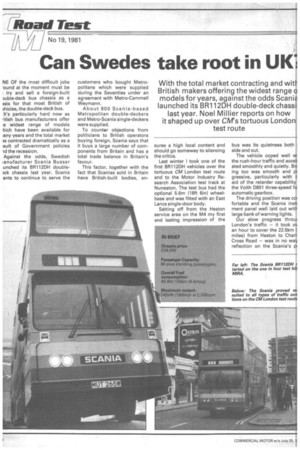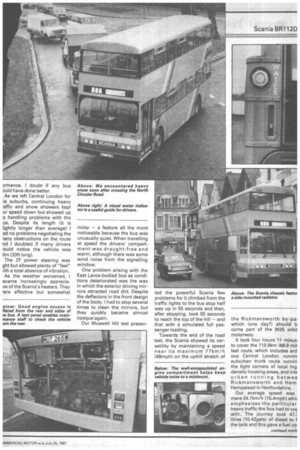Can Swedes take root in UK
Page 32

Page 33

Page 34

If you've noticed an error in this article please click here to report it so we can fix it.
With the total market contracting and wit British makers offering the widest range models for years, against the odds Scani launched its BR112DH double-deck chass last year. Noel Millier reports on how it shaped up over CM's tortuous London test route
NE OF the most difficult jobs .ound at the moment must be
try and sell a foreign-built 3,uble-deck bus chassis as a isis for that most British of ihicies, the double-deck bus. It's particularly hard now as ritish bus manufacturers offer widest range of models hich have been available for rany years and the total market is contracted dramatically as a isult of Government policies id the recession.
Against the odds. Swedish lanufacturer Scania Bussar unched its BR112DH doubleack chassis last year. Scania ants to continue to serve the customers who bought Metropolitans which were supplied during the Seventies under an agreement with Metro-Cammell Weymann.
About 800 Scania-based Metropolitan double-deckers and Metro-Scania single-deckers were supplied.
To counter objections from politicians to British operators buying foreign, Scania says that it buys a large number of components from Britain and has a total trade balance in Britain's favour.
This factor, together with the fact that Scanias sold in Britain have British-built bodies, en sures a high local content and should go someway to silencing the critics.
Last winter I took one of the first BR112DH vehicles over the tortuous CM London test route and to the Motor Industry Research Association test track at Nuneaton. The test bus had the optional 5.6m 118ft Gin) wheelbase and was fitted with an East Lance single-door body.
Setting off from the Heston service area on the M4 my first and lasting impression of the bus was its quietness both ii side and out.
The vehicle coped well the rush-hour traffic and acce114 ated smoothly and quietly. BO ing too was smooth and ph gressive, particularly with t aid of the retarder capability the Voith D851 three-speed fu automatic gearbox.
The driving position was col fortable and the Scania insti ment panel well laid out with large bank of warning lights.
Our slow progress throu, London's traffic — it took or an hour to cover the 22.5km ( miles) from Heston to Cheri Cross Road — was in no wav reflection on the Scania's pi
)rmance. I doubt if any bus auld have done better.
As we left Central London for le suburbs, continuing heavy .affic and snow showers kept ur speed down but showed up o handling problems with the us. Despite its length (it is lightly longer than average) I ad no problems negotiating the tam/ obstructions on the route nd I doubted if many drivers fould notice the vehicle was Urn (33ft long).
The ZF power steering was ght but allowed plenty of "feel" fith a total absence of vibration. As the weather worsened, I ecame increasingly appreciave of the Scania's heaters. They 'ere effective but somewhat noisy — a feature all the more noticeable because the bus was unusually quiet. When travelling at speed the drivers' compartment was draught-free and warm, although there was some wind noise from the signalling window.
One problem arising with the East Lancs-bodied bus as conditions deteriorated was the way in which the exterior driving mirrors attracted road dirt. Despite the deflectors in the front design of the body, I had to stop several times to clean the mirrors, but they quickly became almost opaque again.
Our Muswell Hill test presen ted the powerful Scania few problems for it climbed from the traffic lights to the bus stop half way up in 55 seconds and then, after stopping, took 55 seconds to reach the top of the hill — and that with a simulated full passenger loading.
Towards the end of the road test, the Scania showed its versatility by maintaining a speed near its maximum 7 7km/h (48mph) on the uphill stretch of the Rickmansworth by-pa! which (one day?) should b come part of the M25 orbit motorway.
It took four hours 11 minuti to cover the 110.9km (68.9 mil test route, which includes ard ous Central London runnin suburban trunk route runnin the tight corners of local hig density housing areas, and inte urban running betwee Rickmansworth and Hem Hempstead in Hertfordshire, Our average speed was mere 24.7km/h (15.4mph) whic emphasises the particular heavy traffic the bus had to c(4 with. The journey took 47.: litres (10.42gals) of diesel to f the tank and this gave a fuel coi ription reading of 42.8 100km (6.6mpg).
non-stop run from Hemel npstead to the starting point Heston was covered more .7.kly, and another fuel injeci showed the bus returned a :er 29.411t/100km (9.6mpg) for stretch.
uring part of the journey I k the opportunity to travel as assenger and found the ride n the air suspension just a a bouncy although generally aptable.
lir test bus was particularly catching with bonded glazgiving the windows a ared-off look. From the front bus, with its curved wind?.en, looked particularly well ugh from the back, like some es in trousers, it looked just a a out of proportion.
rterior finish was good, light I airy with moquette seats ng a hint of luxury.
MIRA's test track the ride I handling circuit caused no blems for the bus. During dng tests it pulled up quickly in a straight line, though le of the wheels locked up. nfortunately, our test equipit proved faulty and accurate jency figures are not availat all the usual speeds.
n M1RA's test hills, the fully in bus climbed the one in four gradient with surprising ease. The park brake also held, and the bus restarted easily on this formidable incline. Accelera tion times too were also impressive, with the Scania likely to show a clean pair of heels to many buses by accelerating to 64.36km/h (40mph) in about 27.5 seconds.
The engineering implications of placing Scanias into a fleet should not be a problem. The company has already assumed a maintenance responsibility for the 800 Metro-Scanias and Metropolitans in service in Britain and has established a parts and bus specialist service facility at its lorry dealers.
Our test bus, like the Dennis Dominator and MCW Metrobus, was fitted with the Voith D851 fully automatic retarder equipped gearbox which is already well-proven in service with a large number of British operators.
Engine access is good with the encapsulated engine compartment opening on each side as well as the rear. Among the available features offered are engine compartment lighting, and a control panel with a start button and air pressure gauge to allow maintenance staff to check the engine without entering the driving compartment.
In conclusion, the Scania BR112DH must meet most operators' requirements for a double-deck bus chassis. It has a traditional rigid chassis, and with its air suspension and fully automatic transmission corn plete with retarder it is on a pa with any other new generatior buses.
Drivers will undoubtedly ap predate the comfortable driviric. position and well laid-out instru merit panel, together with ligh controls. Passengers too shout( appreciate the quiet comfor offered by the vehicle.
Its price is competitive, its per formance and fuel consumptior comparable with its rivals and a: such it much merits consider ation.
In a healthier economic cli mate it could well win a share q the British market and could wel provide some new export oppoilr tunities for British double-del bodybuilders too.








































